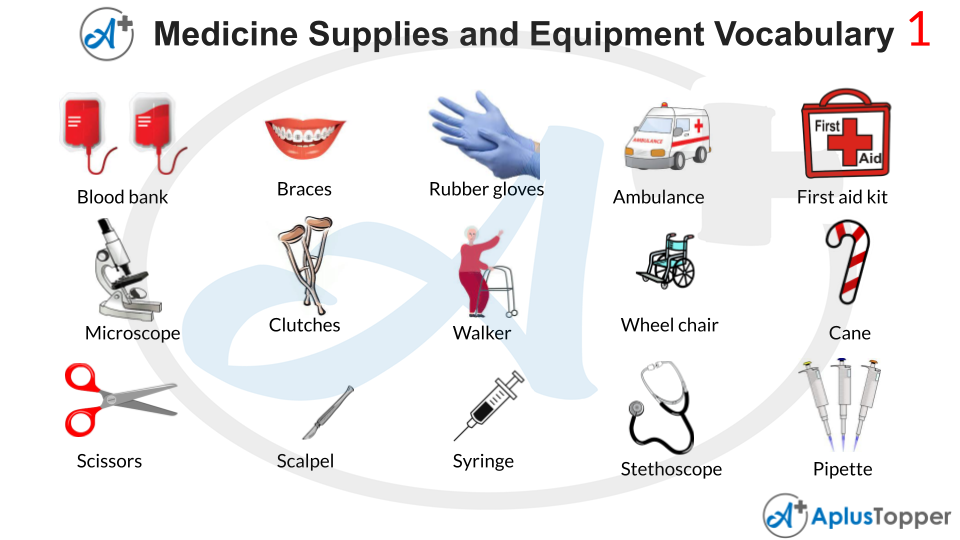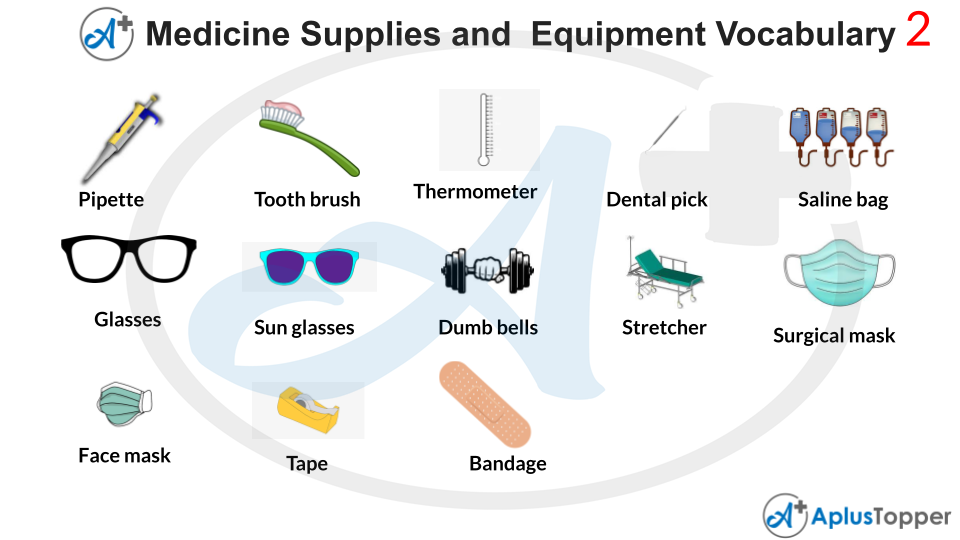Medical Supplies and Equipment Vocabulary: Medicine and medical science have made life possible today. Medicine has advanced immensely in these years, and there are many tools and equipment used for making this field a success. In this writing, we have designed a list of medical supplies and equipment vocabulary. This list of most common medical terms gives a better understanding of the working of the field.
We have also included a list of medical terminologies for these supplies, which will the process of learning even more fun.
List of Medical Supplies and Equipment Vocabulary Words in English
- Name of Medical Supplies and Equipment Vocabulary words
- Description of the Medical Supplies and Equipment words.
Name of Medical Supplies and Equipment Vocabulary Words
It is because of medical science and medical professionals’ we humans are where we are today. This article contains a medical vocabulary list of medical supplies giving us an insight into the medical world and it’s working. There is also the proper description of common medical terminology included.
List of Medical Supplies and Equipment
- Braces
- Syringes
- Cuffs
- Rubber gloves
- Catheters
- Blood bag
- Ambulance
- Medical scissors
- First aid kit
- Clinical swabs
- Microscope
- Crutch
- Walkers
- Walker
- Wheelchair
- Cane
- Scalpel
- Dental floss
- Saline bag
- Medicines
- Surgical Loupes
- Kinesiology Therapeutic Tape
- Bandage
- Stretcher
- Stethoscope
- Medical tape
- Pipette
- Toothbrush
- Thermometer
- Face mask

Description of the Medical Supplies and Equipment Words
Braces
Dental braces are a way for moving or straightening the alignment of the teeth – for improving how they work and how they look. Braces can also help in looking after the long-term health of the gums and teeth. This makes eating more comfortable as it spreads the biting pressure across all the teeth.
Syringes
Syringes are devices used for injecting medication into the body or withdrawing fluid from the body. A medical syringe has a needle that is attached to a hollow cylinder which is fitted with a plunger that slides. It is suggested not to fill the syringes as the plunger might be easily dislodged.
Cuffs
Cuffs are medical devices used for measuring heartbeat and blood pressure simultaneously. It is helpful for the treatment and diagnosis of hypertension. Several other heart-related problems can be detected early by using medical device cuffs.
Rubber gloves
Rubber gloves are personal protection equipment used for protecting not only the wearer but also the patient from the spread of illness or infections during medical examinations and procedures. These are disposable gloves for preventing cross-contamination. Surgical gloves are typically sterile.
Catheters
Catheters are a medical tube that is inserted into the bladder, and it allows the urine to be drained freely. The most well-known reason why catheters are used is to test the bladder after surgery (most commonly urinary tract surgery, bowel or bladder) and rest the bladder after an episode of urinary retention.
Blood bag
Blood bags are used for the collection, storage, transportation and transfusion of blood and its components. The blood donated by a donor is kept in these blood bags until they are needed for any medical purposes.
Ambulance
An ambulance is a vehicle, medically equipped, used for facilitating the transport of patients to their treatment centres. There are specialized medical staff present and paramedics who have been trained to handle critical emergencies. An ambulance also has the essential medical equipment for monitoring and keeping the patient stable until they reach the hospital.
Medical scissors
These scissors have been specially designed to be used by medical professionals for cutting materials like bandages, skin tissue, sutures, clothes or any other material which requires immediate access. They are made out of good quality stainless steel.
First aid kit
A first aid kit is a collection of all the equipment and supplies used for the treatment of minor injuries such as scrapes, cuts, sprains, bruises and burns (mild). It has supplies such as – bandages, scissors, forceps, medical tape, roller gauze, essential medicines, band-aids of many sizes, antiseptic wipes, disinfectants and many more.
Clinical swabs
A clinal swab or nasal swab is a test for checking the bacteria and viruses which cause respiratory infections. There are a number of respiratory infections – using a nasal swab can help the medical professional detect the infection type and provide the immediate and best care for it.
Microscope
Microscopes are mainly used in the laboratories for identifying the microbes and eventually diagnosing the infection. The antibiotics are prescribed on the basis of microbe determination. They are also used for examining cancer and other diseases. Microscopes are primarily used in surgical fields like plastic surgery, dentistry, ophthalmic and neurosurgery.
Crutch
Crutch allows an individual to take some weight off the leg. They can also provide added support if there is an injury or condition of both legs. Crutches are recommended only if an individual has good strength, balance and endurance. It can be used for both short-term injuries or lifelong disabilities.
Walkers
A walker allows the arms of an individual to assist by pushing them down on the frame. This allows the walker to take on some of the weight. This helps in correcting gait and posture. It is also used as an energy saver in case a person has breathing restrictions, heart diseases or fatigues quickly.
Wheelchair
A wheelchair is an assistive device used for promoting mobility and enhancing people’s lives who face any difficulty in walking. There are many types of wheelchairs used depending on the needs of the patient.
Cane
Cane is a walking aid that helps as a substitute for a decrease in range of motion, joint stability, strength, coordination and endurance. It can also help in reducing the stress on a painful limb or joint. Canes always make the experience of walking safer, easier and more comfortable.
Scalpel
A scalpel is a tool used for making incisions on the skin, tissue dissections and various surgical procedures. Surgical scalpels have two parts – a handle and a blade. Scalpel blades are available in various sizes – each having a different purpose – and can be identified by the blade number.
Dental floss
Using dental floss helps in removing plaque, a gel-like, sticky substance made of bacteria that is formed on teeth and between teeth also on the tooth surface under the gum line. It also removes food stuck between the teeth, reduces risks of gum disease, gingivitis and reduces the risk of tooth decay.
Saline bag
A saline bag contains a solution that has the same amount of sodium, similar to 20 snack-sized packets of potato chips. Medical professionals use IV saline for replenishing lost fluids, flush wounds, deliver medicines and sustain patients through dialysis, surgery as well as chemotherapy.
Medicines
Medicines are drugs used for diagnosing, curing, treating or preventing any diseases. Medical professionals prescribe medications to the people whose body isn’t functioning correctly. Medicines are chemicals taken to help with the smooth functioning of the human body.
Surgical Loupes
Surgical loupes help alleviate eye strain by enlarging the image when one is working on tiny things or conducting precision operations. They are portable as well as easier to use than any surgical microscope. They have benefited surgical procedures immensely and have helped in advancing medical science.
Kinesiology Therapeutic Tape
The kinesiology therapeutic tape is used for supporting and relieving the pain in joints, muscles or ligaments. It also reduces swelling by increasing mobility and enhancing recovery. This unique tape improves circulation, allow the internal injury, support muscles and helps in preventing muscle injury while still allowing movement.
Bandage
A bandage is used for supporting any medical device such as splint or dressing. Sometimes also used for providing support to or restricting the movement of any part of the body. When used for the dressing, the bandage is used for holding the dressing (that is directly applied on the wound) in place.
Stretcher
A stretcher is a device used mostly in hospitals for carrying a person from one place to another. It is used for people who must lie down flat and are unable to move on their own. It takes at least two strong people to move the patient on the stretcher.
Stethoscope
A stethoscope is used by medical professionals for listening to the sounds made by the lungs, intestines or heart. It is also used for listening to the arteries and veins. Doctors also sometimes use it for checking blood pressure. The primary function of a stethoscope is to amplify internal sounds.
Medical tape
Medical tape or surgical tape is used for attaching gauze, bandages and other dressings to the skin around any wounds. It is a variety of pressure-sensitive – i.e., tape sticks to the skin and stays in place when firm pressure is applied – adhesive tapes that are used for medical purposes and first aid.
Pipette
A Pipette is a tool used in the laboratory for transporting a measured volume of liquid. Measuring pipettes are made with plastic or glass, and they have a volume marked along the tube. They measure and transport in volumes of millilitres and microliters.

Toothbrush
A toothbrush is used for breaking the plaque and rotating it to clear it away. The bristles on the toothbrush must be long and soft so that they can reach the gaps between the teeth. Toothbrushes are also helpful for cleaning the gums and the tongue. Using a toothbrush properly can decrease the rates of dental problems.
Thermometer
A thermometer (also known as a clinical or medical thermometer) is used for measuring the temperature of humans and animals. Now, digital thermometers are also available that use heat sensors for determining the temperature. The temperature of a person can be measured by placing a thermometer in the armpit or mouth.
Face mask
Face masks or surgical masks are primarily used for providing protection from germs or viruses. It is used as a precaution for preventing the spread of diseases. It is a barrier that stops droplets from reaching another person.
